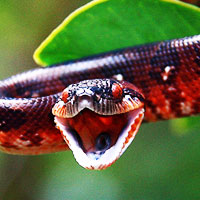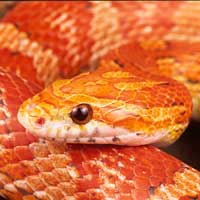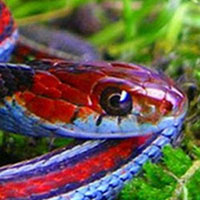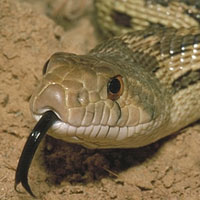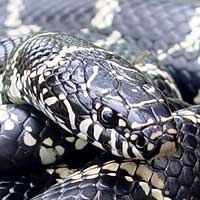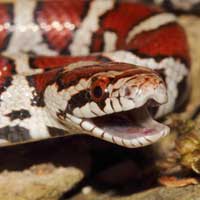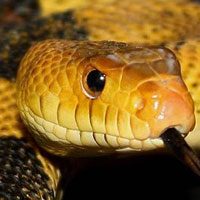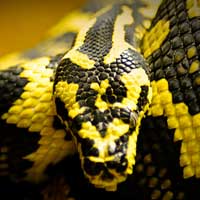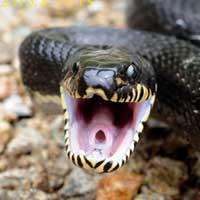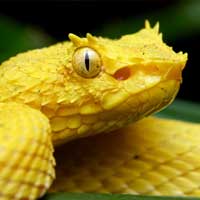Mastering the Care of the Chinese Twin-spotted Rat Snake
The Chinese Twin-spotted Rat Snake, scientifically known as Elaphe bimaculata, belongs to the Colubridae family, which is the largest family of snakes, encompassing a diverse range of non-venomous and mildly venomous species recognized for their adaptability and extensive geographic distribution across various habitats worldwide.
Scientific Name: Elaphe bimaculata
Snake Family: Colubridae
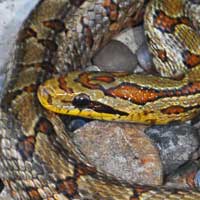
Introduction to the Chinese Twin-spotted Rat Snake
The Chinese Twin-spotted Rat Snake (*Elaphe bimaculata*) is a non-venomous colubrid species native to China and parts of East Asia. Known for its distinct twin spots and elegant pattern, this snake is a favorite among reptile enthusiasts. With its manageable size and docile temperament, the Chinese Twin-spotted Rat Snake is an excellent choice for both beginner and experienced keepers.
Creating the Ideal Habitat for the Chinese Twin-spotted Rat Snake
To ensure the health and happiness of your Chinese Twin-spotted Rat Snake, it is essential to replicate its natural environment. These snakes are often found in forests and rocky terrains. Key habitat elements include:
- Enclosure Size: A 40-gallon tank or larger is ideal for adults.
- Temperature Gradient: Maintain daytime temperatures of 75-85°F, with a basking spot around 90°F, and nighttime temperatures of 65-70°F.
- Humidity: Keep humidity levels between 50-70%, achieved through misting and a water dish.
- Substrate: Use aspen shavings, coconut husk, or a soil-sand mix for natural ground cover.
- Enrichment: Provide climbing branches, rocks, and multiple hides to encourage exploration and natural behaviors.
Below is a habitat setup guide for reference:
| Habitat Element | Specifications |
|---|---|
| Enclosure Size | 40+ gallons |
| Temperature | 75-85°F (day), 65-70°F (night) |
| Humidity | 50-70% |
| Substrate | Aspen shavings, coconut husk, soil-sand mix |
Feeding Your Chinese Twin-spotted Rat Snake
The Chinese Twin-spotted Rat Snake is a carnivorous species with a straightforward diet. Feeding recommendations include:
- Juveniles: Offer pinky mice every 5-7 days.
- Subadults: Provide small to medium-sized mice every 7-10 days.
- Adults: Feed adult mice or small rats every 10-14 days.
- Prey Type: Use pre-killed prey to avoid injury and stress during feeding.
- Hydration: Ensure a fresh supply of water is available at all times in a shallow dish.
Maintaining a consistent feeding routine ensures your snake’s health and vitality.
Behavior and Temperament of the Chinese Twin-spotted Rat Snake
Understanding the behavior of the Chinese Twin-spotted Rat Snake can help you provide optimal care. Key traits include:
- Activity Level: These snakes are primarily nocturnal, meaning they are most active during the evening and night.
- Climbing Skills: They are agile climbers and appreciate vertical space and branches in their enclosure.
- Docile Nature: This species is generally calm and tolerates handling well, making it a good choice for beginners.
- Stress Indicators: Excessive hiding, refusal to eat, or frequent defensive behaviors may indicate stress or unsuitable conditions.
Providing a secure and enriched environment helps ensure your snake exhibits natural behaviors and stays stress-free.
Health and Lifespan of the Chinese Twin-spotted Rat Snake
With proper care, the Chinese Twin-spotted Rat Snake can live 15-20 years in captivity. Important health considerations include:
- Common Issues: Respiratory infections, improper shedding, and mite infestations are common concerns.
- Preventative Measures: Maintain stable temperature and humidity levels and clean the enclosure regularly.
- Veterinary Care: Schedule annual check-ups with an exotic animal veterinarian to monitor overall health.
- Observation: Watch for signs of illness, such as lethargy, lack of appetite, or unusual behaviors.
Proactive care and regular monitoring are key to ensuring a long and healthy life for your snake.
Reproduction and Breeding of the Chinese Twin-spotted Rat Snake
Breeding the Chinese Twin-spotted Rat Snake in captivity can be rewarding but requires preparation. Key factors include:
- Breeding Season: Typically occurs in spring after a winter brumation period.
- Clutch Size: Females lay 5-10 eggs per clutch.
- Incubation: Eggs should be incubated at 80-85°F for 50-60 days.
- Hatchling Care: Provide small enclosures and appropriately sized prey for hatchlings.
Proper preparation and attention to environmental conditions ensure successful breeding and healthy offspring.
Handling and Caring for the Chinese Twin-spotted Rat Snake
Handling and caring for the Chinese Twin-spotted Rat Snake is straightforward with the right knowledge. Follow these tips:
- Handle the snake gently, supporting its entire body to minimize stress.
- Avoid handling immediately after feeding to prevent regurgitation.
- Provide enrichment such as climbing structures and hiding spots to mimic natural behaviors.
- Keep the enclosure clean and monitor their health regularly.
- Establish a consistent routine for feeding, cleaning, and interaction to build trust.
With proper care and attention, the Chinese Twin-spotted Rat Snake can become a fascinating and rewarding pet.
Other Snakes In This Species
 Aesculapian Rat Snake
Aesculapian Rat Snake Amur Russian Rat Snake
Amur Russian Rat Snake Bairds Rat Snake
Bairds Rat Snake Black Rat Snake
Black Rat Snake Chinese Twin-spotted Rat Snake
Chinese Twin-spotted Rat Snake Diadem Rat Snake
Diadem Rat Snake Diones Rat Snake
Diones Rat Snake Eastern Fox Snake
Eastern Fox Snake Everglades Rat Snake
Everglades Rat Snake Four-lined Rat Snake
Four-lined Rat Snake Gray Rat Snake
Gray Rat Snake Great Plains Rat Snake
Great Plains Rat Snake Green Rat Snake
Green Rat Snake Ladder Rat Snake
Ladder Rat Snake Leopard Rat Snake
Leopard Rat Snake Mandarin Rat Snake
Mandarin Rat Snake Radiated Rat Snake
Radiated Rat Snake Steppes Rat Snake
Steppes Rat Snake Texas Rat Snake
Texas Rat Snake Trans-Pecos Rat Snake
Trans-Pecos Rat Snake Trinket Rat Snake
Trinket Rat Snake Yellow Rat Snake
Yellow Rat Snake
